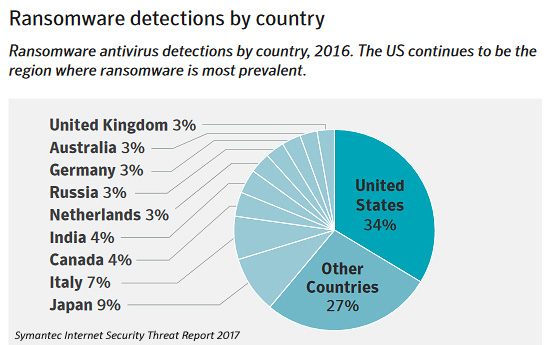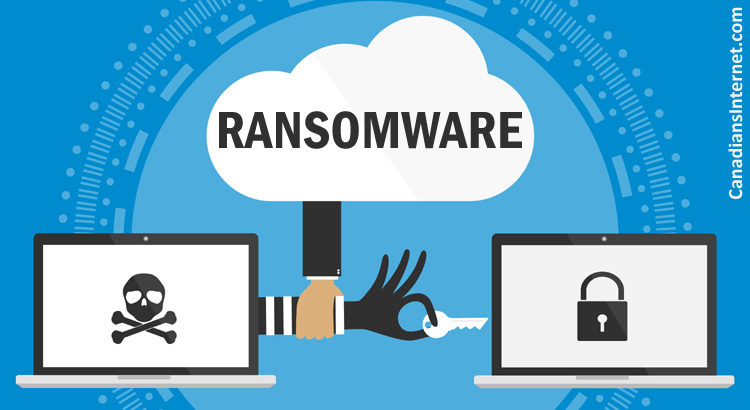With the widespread Ransom.WanaCrypt0r. (WanaCry) attacks in the news, the world has become painfully aware of the havoc encrypted ransomware can cause. It has infected the PC’s, Macs, mobile devices, networks and servers of both individuals and businesses of all sizes. There are many versions of ransomware, including Jaff, Locky, Sage, Cerber, Spora, Cryptoblock, SamSam, Findzip, Goldeneye, KeRanger and more.
The US is the top target by far but the infection rate is growing in other countries, including Canada. Recently, a Canadian insurance company lost almost a million dollars USD as a result of a ransomware attack. Global attacks also include Canadian companies.
The following chart illustrates detections by Symantec (Norton), which is not to be confused with the much higher number of attacks they actually blocked.

Once infected, your spreadsheets, documents, photos, videos and other files will no longer be accessible to you. The ransom demanded to release your encrypted data can range from a few hundred dollars to hundreds of thousands. The mean average ransom demanded by attackers increased from $294 to $1,077 in 2016, according to the 2017 Symantec Internet Security Threat Report.
You will see a screen similar to this one if you’ve been infected:

There are several ways hackers can infect computers or operating systems, but it usually starts with a single email. The recipient clicks on a link or opens an attachment, the attack begins and your business comes to a grinding halt. You can also be infected via downloads (including apps) or file sharing, or by clicking links in pop-up windows when browsing the Internet.
Prevention is Your Best Defense Against Ransomware
Once you’ve been infected by ransomware, there is little you can do but pay the ransom or start again with a clean operating system and secured backup files. Prevention is the most effective way to protect your business and customer data.
Some malware prevention software is better than others. We found out the hard way that those who specialize in malware will find and prevent it better than your average anti-virus software.
The first time we ran MalwareBytes, it found (and fixed) a long list of malware that our anti-virus software missed. One of the reasons we tried it was to be rid of stubborn malware that added advertisements and messed with search results. We ran our anti-virus software and it would seem like it was gone, only to come back when we restarted our laptop. After downloading the MalwareBytes free trial and running it once, the malware was gone. We subscribed to their premium anti-malware software and have used it in combination with standard anti-virus software ever since.
After several years of excellent performance, we weren’t surprised when MalwareBytes announced they were specializing in ransomware prevention as well.
MalwareBytes stops unknown and known ransomware with proprietary technology that works proactively to shield your files. This is a powerful, complete defense that blocks ransomware, and not a simple decryption tool. That means you’re protected from new threats even before they’ve been identified, including the most recent and widespread ransomware, Ransom.WanaCrypt0r (WannaCry).
“Malwarebytes signature-less anti-exploit technology blocks the infection vector, while our anti-malware technology blocks the payload pre-execution,” their website explains. “Our anti-ransomware technology prevents users’ files from being encrypted and will stop any future unknown ransomware variants. It combines multiple security layers with the best-informed telemetry to block an attacker at every stage of the kill chain.”
Other ways to prevent infection include:
- Keep your operating system and software updated. Automatic updates ensure you have the latest security updates and patches.
- Exercise extreme caution when clicking links in emails and when opening email attachments (such as zipped files, documents, javascript or files with a .exe extension). Additionally, ignore requests to “enable macros” in Microsoft Office emails.
- Stay informed and send virus tips to your staff regularly so caution is always their first instinct.
- Remind staff to avoid sharing sensitive information about the company or its network by email or phone.
- Restrict the ability of staff to install anything on your network. Only download software from websites you trust and double check to make sure you’re on the company’s true website.
- Get serious about backups! First, run a complete virus scan. Then, connect to your external hard drive or USB storage device and run the backup. Once the backup is complete DISCONNECT THE STORAGE DEVICE. This is critical because if ransomware is installed on your computer, it will also encrypt connected storage devices. You may prefer to back up your data to the cloud, but make sure the cloud storage provider uses bulletproof encryption and authentication.
“The best protection against ransomware is having a good backup routine in place that makes copies to an external storage device that’s not always connected to the computer,” suggests PC World Magazine.
If you are attacked by ransomware, report it to law enforcement such as Canadian Anti-Fraud Centre in Canada or your local FBI field office in the United States.
Have you ever been a victim of ransomware? How did you handle it?
✔ You may also be interested in reading:
eCommerce and Online Sales Fraud Prevention in Canada
——————————————
© CanadiansInternet.com – Content on this website may not be used elsewhere without expressed permission. Thank you for respecting the effort that we have put into our original content.
DISCLOSURE: We may receive compensation for links to products on this website. As an Amazon Associate, we earn from qualifying purchases. Our content is provided for informational purposes only and does not guarantee results.
COMMENTS ARE MODERATED – Legitimate comments will be published after a short delay. Spam will not be published.
Melody McKinnon is an internet entrepreneur with 25 years of experience in a wide range of online business models, backed by a formal business education and enhanced by training and mentorship. She has owned or managed both educational and ecommerce websites. Her book, 7 Recession Proof Online Businesses to Start From Home, is available from all major ebook retailers.
Melody has worked with many businesses & brands in a multitude of capacities. She can often be found on CanadianDigitalMedia.com, CanadiansInternet.com, CanadianFamily.net, and AllNaturalPetCare.com, as well as other quality digital publications. Her content has earned reference links from highly-respected websites, magazines and university textbooks.
Follow Melody McKinnon on Medium:
https://medium.com/@business_32556































Security is THE most important concern for entrepreneurs because small businesses can be easy targets. I’m going to use every tool out there to protect my site & customers!
I felt so helpless and angry when I got hit with ransomeware! The police said there’s nothing they can do. It was an old laptop so I trashed it so I wouldn’t have to pay the losers. Then I went googling to make sure I’m armed to the teeth against future attacks. That’s how I found this article :-). Thanks for the pointers! We can beat these losers if we all learn how.
Thank you! I’ve been hearing about ransomware and it terrifies me! I didn’t realize it was easy to prevent. I’m investing in malware bytes right away and unplugging my EHD after back ups.